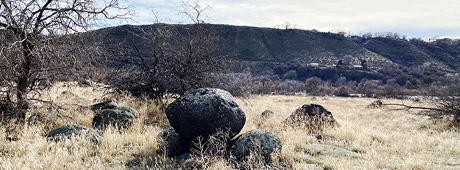No products in the cart.
The Flood at the Springs

Vision of an Ancient Spectacle
By Bruce Collier
My bird dog Kyra and I have been here many times before. I should be contemplating the pheasants and the cover that hides them from us, but I’m always distracted when I arrive at this overlook and peer down into the Snake River. I never fail to ponder the cataclysmic event that occurred here a long time ago. The impacts of that event are clearly visible after the passage of thousands of years.
Today is a cold, sunny December morning. The drive down here to the river from my home in Blaine County took a little less than two hours. I proceeded through the Wood River Valley, past Shoshone, and then turned at Wendell to reach the northern rim of the Snake River Canyon. I stopped at an overlook on the canyon rim, just where the road turns to gravel and descends to the river some three hundred vertical feet below. The view from here is spectacular. I can see upstream and downstream for miles. From this vantage point the river seems distant and small. The valley it runs through is broader directly below me than it is upstream. There is a precipitous basalt wall along my northern side of the canyon. The far side of the valley also has high ramparts but they’re less sheer. The gravel road proceeds down sharply and cuts across the canyon’s northern wall.
Kyra and I are here to hunt pheasants on the lands of a wildlife management area in the valley below. The WMA is generally identified as Niagara Springs, part of a state park that provides not only hunting but also horse trails, fishing, and campsites. The place got its name from a large spring that emanates from the northern canyon wall to provide clean water for a state fish hatchery in the river valley.
I’m fascinated by what happened here on the Snake River around 17,400 years ago. I use that time estimate from some geologists, although others argue the event might have occurred as recently as 14,500 years ago.
Everyone has heard about events or conditions that are said to be of “biblical proportions.” This phrase refers most often to the flood during the Old Testament time of Noah. Yet the cliché is frequently misused, as in: “The traffic between Ketchum and Hailey at 4:30 p.m. was of biblical proportions.” But what happened at this place where I now stand truly deserves the phrase. Even Noah would have been impressed by the Bonneville Flood.
I’m interested in the impact the flood had on my hunting spot today and on the entire Snake River Canyon, as well as on the plants and animals that lived here all those years ago. But I’m not a geologist, paleontologist, or expert of any kind. My interest arises from an earth science class I took at North Junior High in Boise in 1964. The class instructor was Howard Rice, a wonderful educator who contributed much to my enjoyment of life by pointing out the features of our natural world and explaining why things happened. He taught me and my classmates many things about physical geology, such as mountain-building, erosion, and the Mohs hardness scale, which ranks minerals on their ability to scratch one another. Mr. Rice was also a paleontologist and collected fossils in the Hagerman area, only about a dozen miles downstream from my Niagara Springs overlook.
In the early 1960s, a geologist with the U.S. Geological Survey named Harold E. Malde did significant research and compiled a comprehensive history of events leading up to the Bonneville Flood. It included the flood’s dramatic geological impacts on the Snake River and the canyon that extends from the Pocatello area to Hells Canyon. Malde updated geological studies done in late-1800s by G. K. Gilbert, who is credited with naming the event the Bonneville Flood. Since the work done by these two men, other geologists have completed extensive studies of the flood and compiled much information about its cause, size, and impact. Of particular value to me in understanding the flood are books written and videos produced by Professor Shawn Willsey of the College of Southern Idaho. Donald K. Grayson’s book, Giant Sloths and Sabertooth Cats (University of Utah Press, 2016), describes the flora and fauna of the Great Basin region during the later years of the Pleistocene Epoch. These scientists and others provided me with information about the history of Niagara Springs.
The Pleistocene Epoch began about 2.6 million years ago and continued until approximately 11,700 years ago. The Ice Age occurred during this epoch. Over that time, massive ice sheets repeatedly advanced south and then retreated north, covering much of Canada and the northern tier of the United States. None of the ice sheets reached as far south as Niagara Springs but the cold and wet climate of the Ice Age still had an impact on all of southern Idaho.
This content is available for purchase. Please select from available options.
Purchase Only
Purchase Only

One Response to The Flood at the Springs
Kirsten Morgan -
at
I love this very thorough explanation of nature’s fickle power, as forces beyond imagination carve & shape an environment that we later believe has always held that form. Thanks for this very interesting article!